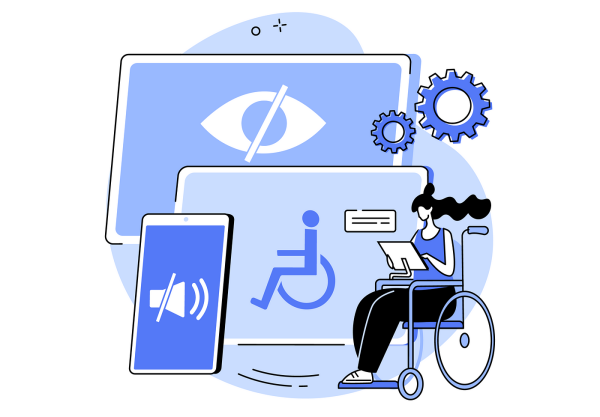Introduction
We all know, technology plays an increasingly central role in our lives, from communication and education to commerce and entertainment. However, for many individuals with disabilities, accessing and interacting with technology can present significant challenges. Designing for accessibility is essential to ensure that technology is inclusive and accessible to all users, regardless of their abilities.
In this blog post, we’ll explore the importance of designing for accessibility and share practical tips and strategies for creating digital experiences that are inclusive and accessible to everyone.
Understanding Accessibility:
Accessibility refers to the design of products, devices, services, or environments that are usable by people with disabilities. This includes individuals with visual, auditory, physical, cognitive, or neurological impairments. Accessibility is about removing barriers and providing equal access to information and functionality, enabling individuals with disabilities to participate fully in society and achieve their goals.
The Importance of Accessibility in Technology:
Accessible technology has the power to transform lives by enabling individuals with disabilities to access information, communicate with others, pursue education and employment opportunities, and participate in social and cultural activities. However, despite the significant advancements in technology, many digital products and services still lack basic accessibility features, excluding millions of people with disabilities from fully engaging with technology.
Designing for accessibility not only benefits individuals with disabilities but also enhances the user experience for everyone. For example, captioning videos not only makes them accessible to individuals with hearing impairments but also improves comprehension for users in noisy environments or non-native speakers. Similarly, providing alternative text for images not only benefits users with visual impairments but also improves search engine optimization and helps users understand the context of images.

Key Principles of Accessible Design:
Perceivable: Ensure that information and user interface components are perceivable by all users, regardless of their sensory abilities. This includes providing alternative text for images, captions for videos, and clear and legible text.
Operable: Ensure that user interface components and navigation are operable by all users, including those who use assistive technologies such as screen readers or voice recognition software. This includes providing keyboard shortcuts, ensuring sufficient time for users to interact with content, and avoiding content that may cause seizures.
Understandable: Ensure that content and user interface components are understandable by all users, regardless of their cognitive abilities. This includes using clear and concise language, organizing content in a logical manner, and providing helpful error messages and instructions.
Robust: Ensure that content and user interface components are robust enough to be interpreted reliably by a wide variety of user agents, including assistive technologies. This includes using standard HTML, CSS, and JavaScript practices and testing for compatibility with assistive technologies.

Practical Tips for Designing Accessible Technology
Conduct Accessibility Audits: Regularly review and evaluate the accessibility of your digital products and services using tools such as screen readers, keyboard navigation, and color contrast checkers.
Involve Users with Disabilities: Include individuals with disabilities in the design and testing process to gain insights into their needs and preferences and identify potential barriers to accessibility.
Provide Multiple Means of Access: Offer multiple ways for users to access content and functionality, such as keyboard shortcuts, voice commands, and alternative navigation paths.
Prioritize Semantic HTML: Use semantic HTML markup to ensure that content is structured in a meaningful and accessible way, making it easier for assistive technologies to interpret and navigate.
Design with Inclusivity in Mind: Consider the diverse needs and preferences of users from the outset of the design process, incorporating accessibility features and considerations into every stage of development.
Prioritizing Accessibility for All Users
Designing for accessibility is not just a matter of compliance; it’s about creating technology that is inclusive and accessible to everyone, regardless of their abilities. By prioritizing accessibility in the design process, developers can ensure that their products are usable by a wider audience, including individuals with disabilities. This involves considering factors such as screen readers for the visually impaired, keyboard navigation for those with motor impairments, and captions or transcripts for videos for the hearing impaired.

Furthermore, designing for accessibility benefits not only those with disabilities but also improves the overall user experience for everyone. For example, implementing clear and concise navigation benefits users with cognitive impairments, but it also makes the user experience more intuitive and efficient for all users. Additionally, accessible design practices often result in cleaner, more streamlined interfaces that are easier to navigate and understand.
Incorporating accessibility into the design process from the outset is essential for creating inclusive technology that meets the needs of all users. By adopting a proactive approach to accessibility, developers can ensure that their products are not only compliant with accessibility standards but also genuinely inclusive and welcoming to all individuals, regardless of their abilities.
Conclusion
Designing for accessibility is not only a legal and ethical requirement but also a fundamental aspect of creating technology that is truly inclusive and empowering for all users. By understanding the principles of accessible design and incorporating accessibility features into digital products and services, we can ensure that technology is accessible to everyone, regardless of their abilities.As designers, developers, and technologists, we have the power and responsibility to make the digital world a more inclusive and accessible place for all.
Let’s work together to create a future where technology is truly for everyone.
Related Posts





